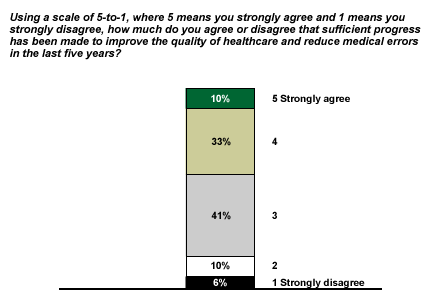In the last few years, Americans have grown more dissatisfied with the quality of medical care in the United States. It appears, at least from the results of our recent ║┌┴¤═° Poll Panel healthcare survey*, that many people aren't wholly convinced that the healthcare industry is doing all it should to change the situation.
When asked to rate the extent to which they agree that sufficient progress has been made in the last five years to improve the quality of healthcare and reduce medical errors, just 43% of respondents give a "4" or "5" on a 5-point scale. Critics would likely say this perception reflects the current credibility problem plaguing the U.S. healthcare system.

What was the genesis of this concern? Industry analysts might track it back to the medical quality public relations crisis that began after the release of a landmark 1999 Institute of Medicine (IOM) report, which claimed nearly 100,000 deaths each year are attributable to avoidable medical errors. It definitely affected health professionals and politicians, but what about others? Not many respondents say they are familiar with the report -- just 26% know about it.
Still, I'm not willing to easily dismiss the influence of that report as the genesis of heightened concern about the quality of medical care in many hospitals. In response to a Kaiser Foundation survey conducted just after the IOM report's release, 51% of Americans said they were following the story "very" or "fairly" closely. And while many panelists now say they are unfamiliar with the report, they are more likely to have seen one of the many headlines or news clips on medical errors in local facilities that sprang indirectly from the publicity surrounding the report, without being aware of the catalyst.
Though cost is respondents' overriding concern when it comes to healthcare, that issue is more likely to be addressed at the broad public-policy level. Individual providers have a greater capacity to address quality concerns. Finding ways to lower costs and improve access is most likely to ease people's minds -- but it will also take sustained quality improvement efforts to truly restore their confidence.
Quality Now Suspect
In the interim, what are the implications of medical errors and quality concerns? One would assume consumers neatly categorize facilities into hospitals of exceptional quality, hospitals of acceptable quality, and hospitals that people want to avoid because of poor quality. But with rare exceptions, few hospitals successfully differentiate themselves on quality. It is more likely facilities fall into two categories for consumers: those with acceptable quality and those they do not want to go to because of quality concerns.
The IOM report and the attendant press coverage have made it more difficult for hospitals to position themselves on quality. Before the report, "acceptable" hospitals may have been able to move to the "exceptional" category, but now all hospitals start with a perceived quality deficit. Quality is now suspect and hospitals have to dig themselves out.
*These results are based on telephone surveys with a randomly selected national sample of 1,010 adults in the ║┌┴¤═° Poll Panel of households, aged 18 and older, conducted in September 2005. For results based on this sample, one can say with 95% confidence that the maximum error attributable to sampling and other random effects is ┬▒3 percentage points. In addition to sampling error, question wording and practical difficulties in conducting surveys can introduce error or bias into the findings of public opinion polls.
